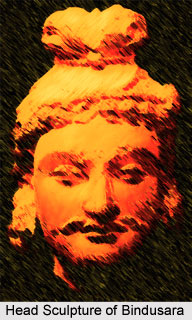 Bindusara was the son of Chandra Gupta Maurya. After Chandra Gupta`s death, Bindusara succeeded the throne in 299 B.C. Vayu Puran describes his name as `Bhadrasar`. According to Greek writers, he had taken the title of `Amitra ghad` or `slayer of enemies`. But there is no evidence and details of his conquests. However, a vague hint is given by the author of `Arya-manju-sri mula-kalpa` and by Hem Chandra and Taranath who wrote, "That the apostle of violence, Chanakya outlived Chandra Gupta and continued as minister of Bindusara as one of his great lords."
Bindusara was the son of Chandra Gupta Maurya. After Chandra Gupta`s death, Bindusara succeeded the throne in 299 B.C. Vayu Puran describes his name as `Bhadrasar`. According to Greek writers, he had taken the title of `Amitra ghad` or `slayer of enemies`. But there is no evidence and details of his conquests. However, a vague hint is given by the author of `Arya-manju-sri mula-kalpa` and by Hem Chandra and Taranath who wrote, "That the apostle of violence, Chanakya outlived Chandra Gupta and continued as minister of Bindusara as one of his great lords."
Conquests
Like his father Bindusara also followed an imperialistic policy. According to Buddhist and Jain traditions Chanakya outlived Chandra Gupta and in the early days of Bindusara, he helped him a lot. According to Tibetan historian, Taranath, Chanakya helped Bindusara in destruction of the kings and ministers of sixteen towns and made Bindusara the master of all territory between the eastern and western sea. On the basis of this account some writers hold the view that Bindusara had also made certain conquests in the south. But other scholars have disowned this view. They have stated that India was subdued and conquered by Chandra Gupta. They also said that Bindusara had not added any new area to his empire. Probably he had suppressed a few rebellions, which had taken place in his empire.
Revolt of Uttrapath
Susima was the eldest son of Bindusara. He ruled in Uttrapath as a provincial governor. Being dissatisfied with the Maurya ministers, the people of Taxila rose in revolt. Susima failed to suppress this revolt. Then Bindusara sent his other son, prince Ashoka to quell the revolt. According to Divyavadan, when Ashoka reached Taxila, all the people of Taxila came out and said, "We neither oppose the prince, nor the king Bindusara but the wicked ministers who oppress us." Ashoka adopted a very co-operative attitude with the people and was successful in suppressing the revolt. Divyavadan also describes another revolt, which was quelled by Susima.
Foreign policy
Besides keeping his father`s empire intact, Bindusara has also maintained good and friendly relations with foreign countries. Bindusara followed the same policy, which had been started by Chandra Gupta. Antiochus sent Daimachus, who was the son of Selukus as an ambassador in the court of Bindusara. According to Pliny, king Ptolemy of Egypt had also sent his ambassador, Dionyaisys, as an ambassador to India. Once Bindusara wrote to Antiochus "Send me sweet wine, dry figs and a sophist i.e. philosopher".
Antiochus replied, "I here by send you sweet wine and dry figs, but a sophist is not sold in Greece."
On the basis of these references it can be said that India had commercial contacts with countries abroad.
Death and estimate
According to the Purans, Bindusara ruled for 25 years. Thus according to Purans, he died in 273 B.C. But according to Buddhist tradition he ruled for 27 or 28 years. The reign of Bindusara has no special significance in the history of India. This does not, however, mean that he was not an able ruler. According to `Arya-manju-sri-mula-kalpa`, he was a very witty, wise, clever, polite tongued and a courageous man. He was especially interested in the religion. In his seventh pillar inscription Asoka had got it written that his predecessor king did the propagation of dharama. Probably his indication was towards Bindusara. Thus Bindusara can be called as a powerful and benevolent ruler.



















